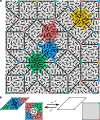Compression theory for inhomogeneous systems
- PMID: 39587048
- PMCID: PMC11589113
- DOI: 10.1038/s41467-024-54341-8
Compression theory for inhomogeneous systems
Abstract
The physics of complex systems stands to greatly benefit from the qualitative changes in data availability and advances in data-driven computational methods. Many of these systems can be represented by interacting degrees of freedom on inhomogeneous graphs. However, the lack of translational invariance presents a fundamental challenge to theoretical tools, such as the renormalization group, which were so successful in characterizing the universal physical behaviour in critical phenomena. Here we show that compression theory allows the extraction of relevant degrees of freedom in arbitrary geometries, and the development of efficient numerical tools to build an effective theory from data. We demonstrate our method by applying it to a strongly correlated system on an Ammann-Beenker quasicrystal, where it discovers an exotic critical point with broken conformal symmetry. We also apply it to an antiferromagnetic system on non-bipartite random graphs, where any periodicity is absent.
© 2024. The Author(s).
Conflict of interest statement
Competing interests: The authors declare no competing interests.
Figures




References
-
- Wilson, K. G. Renormalization group and critical phenomena. I. Renormalization group and the Kadanoff scaling picture. Phys. Rev. B4, 3174–3183 (1971).
-
- Kadanoff, L. P. Scaling laws for Ising models near Tc. Phys. Phys. Fiz.2, 263–272 (1966).
-
- Ma, S.-k, Dasgupta, C. & Hu, C.-k Random antiferromagnetic chain. Phys. Rev. Lett.43, 1434–1437 (1979).
-
- Iglói, F. & Monthus, C. Strong disorder rg approach of random systems. Phys. Rep.412, 277–431 (2005).
Grants and funding
LinkOut - more resources
Full Text Sources

